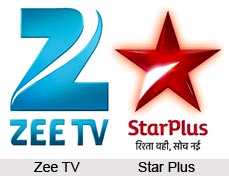History of Indian Radio
 History of Indian Radio is the history of radio broadcast that started in India with the setting up of a private radio service in Chennai, in the year 1924. In that same year, British government gave license to the Indian Broadcasting Company, to launch Radio stations in Mumbai and Kolkata. Later as the company became bankrupt, the government took possession of the transmitters and began its operations as the Indian State Broadcasting Corporation. In the year 1936, it was renamed All India Radio (AIR) and the Department of Communications managed it entirely. After independence, All India Radio was converted into a separate Department. All India Radio has five regional headquarters in New Delhi, for the North Zone; in Kolkata, for the East Zone; in Guwahati, for the North-East Zone, in Mumbai, for the West Zone; and in Chennai, for the South Zone.
History of Indian Radio is the history of radio broadcast that started in India with the setting up of a private radio service in Chennai, in the year 1924. In that same year, British government gave license to the Indian Broadcasting Company, to launch Radio stations in Mumbai and Kolkata. Later as the company became bankrupt, the government took possession of the transmitters and began its operations as the Indian State Broadcasting Corporation. In the year 1936, it was renamed All India Radio (AIR) and the Department of Communications managed it entirely. After independence, All India Radio was converted into a separate Department. All India Radio has five regional headquarters in New Delhi, for the North Zone; in Kolkata, for the East Zone; in Guwahati, for the North-East Zone, in Mumbai, for the West Zone; and in Chennai, for the South Zone.
In the year 1957, All India Radio was renamed Akashvani, which is controlled by the Ministry of Information and Broadcasting. During the period of independence only a mere 6 radio stations existed through out the country. But during the late 1990s, the network of All India Radio extended to almost 146 AM stations. Moreover the Integrated North-East Service focused on reaching to the population in northeast India. All India Radio offers programmes in English, Hindi and numerous regional and local languages. In the year 1967, Commercial Radio services started in India. The initiative was taken by Vividh Bharati and Commercial Service, from the headquarters in Mumbai. Vividh Bharati accumulated revenues from widespread sponsorships and advertisements. During the mid-1990s, broadcasting was carried on from 31 AM and FM stations.
By 1994, there were around 85 FM stations and 73 short wave stations that linked the whole nation. The broadcasting technology in India is basically indigenous and reaches far and wide to various listeners like farmers who require various updated information on agriculture. Between 1970 and 1994, the amount of radio receivers increased manifold, almost five times. From the initial 14 million, the number increased to a staggering 65 million. The broadcast services from foreign countries are provided by the External Services Division of All India Radio. Almost 70 hours of news, entertainment programmes were broadcasted in 1994 in various languages with the help of 32 shortwave transmitters.
After Independence, Indian radio was regarded as a vital medium of networking and communication, mainly because of the lack of any other mediums. All the major national affairs and social events were transmitted through radio. Indian radio played a significant role in social integration of the entire nation. All India Radio mainly focused on development of a national consciousness as well as over all National integration. Programming was organised and created keeping in mind the solitary purpose of national political integration. This supported in prevailing over the imperative crisis of political instability, which was created after the Independence. Thus political enhancement and progressive nation building efforts were aided by the transmission of planned broadcasts.
All India Radio also provided assistance in enhancing the economic condition of the country. Indian radio was particularly designed and programmed to provide support to the procedure of social improvement, which was a vital pre-requisite of economic enhancement. The leading development beliefs of the time analysed the problems and hindrances in development as the primary ones in the developing nations. The function of broadcasting paved a way for the surge of modern concepts. Later, with the modernisation of the country, television was introduced and broadcasting achieved new status. But by then, radio had become a veteran medium in India. Diverse programmes including entertainment and melodious songs were also transmitted nationwide. Akashvani or All India Radio still stands as one of the biggest radio networks around the globe.
Developments of Indian Radio
 Developments of Indian Radio are the saga of the various steps of the evolution and development of the medium. The quick and dramatic changes of Indian radio are usually credited to Broadcasting Authority of India. The national television or the Doordarshan and All India Radio, or Akashwani networks had been state-owned and was controlled by the Ministry of Information and Broadcasting. The news reporting through radio customarily presented the government`s point of view and there was hardly any public interaction. The newsreaders used to narrate their script and the audience would listen to the frequency according to their choice.
Developments of Indian Radio are the saga of the various steps of the evolution and development of the medium. The quick and dramatic changes of Indian radio are usually credited to Broadcasting Authority of India. The national television or the Doordarshan and All India Radio, or Akashwani networks had been state-owned and was controlled by the Ministry of Information and Broadcasting. The news reporting through radio customarily presented the government`s point of view and there was hardly any public interaction. The newsreaders used to narrate their script and the audience would listen to the frequency according to their choice.
In 1990 V.P. Singh`s National Front government provided financial aid to the Prasar Bharati (Indian Broadcasting) Act that was considered by Parliament. This act provided greater autonomy to Doordarshan and All India Radio. The changes that resulted in the scenario of Indian radio were limited. The bill allowed the establishment of an autonomous body to control Doordarshan and All India Radio. This unit operated under a board of governors, who were appointed for policy making and a broadcasting council to respond to the complaints. This was the start of interaction through radio.
With time the number of radio stations has increased from about 100 in 1990 to 209 in 1997. Indian radio now has tremendous reach and presents the best option for low-cost programming. Listener ship of Indian Radio has reached a plateau. At times the listener ship has risen in certain urban areas due to the recent time allotment to private companies on five FM stations. Film and other popular music constitute the main curriculum of such stations, contributing to an increase in commercial time radio and thus earn advertising revenues from Rs. 527 million in 1991-2 to Rs. 809 million in 1995-96.
The noticeable development in Indian radio has been the proper efforts that were taken to use radio for social change, like the state-supported radio rural forums for agricultural communication in the 1960s and promotion of adult literacy in the 1980s. The advent of regional radio in India popularised this medium even more. More recently NGOs have come together and initiated several broadcast programmes on women and legal rights, emergency contraception, and tele-serials that deal with social issues. Although Indian Radio saw almost no improvement in its initial years, in the present decade the functioning of regional radio channels have lead to a massive network all across the country.
Local broadcasting, reflecting local issues of concern to the community is another development of Indian radio. Some communication experts believe that an increased and accelerated commercialisation of radio will eventually cut down the costs of FM radio sets, thus making local radio even more available to the extreme rural areas of the country. Presently, radio broadcasting is done in 24 languages and 146 dialects all across India and there are 104 million radio households in the country, using approximately 111 million radio sets.
The inclusion of FM facility in mobile phones and portable pocket radios have popularised this medium in every nook and corner of urban areas. Although the transmitters have not reached the extreme corners, developments assure quick installation; a recent survey shows that Indian radio reaches out to almost 97.3% of the country`s population and 91% of the country`s geographical area. A March 1996 survey, says that there had been around 186 radio-broadcasting centers, 148 medium wave transmitters, 51 short wave transmitters and 94 VHF/FM transmitters in India.
Indian Radio now enjoys equal importance as television and print media. The developments of radio in India was steady during the 1960s and 70s, but accelerated during the 1980s and 90s. Radio has now become an intimate form of communication and the FM channels like Red FM, Radio Mirchi, Power Fm and others have contributed greatly in developing this strong network.



















